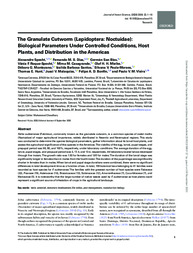The Granulate Cutworm (Lepidoptera: Noctuidae): Biological Parameters Under Controlled Conditions, Host Plants, and Distribution in the Americas.
The Granulate Cutworm (Lepidoptera: Noctuidae): Biological Parameters Under Controlled Conditions, Host Plants, and Distribution in the Americas.
Author(s): SPECHT, A.; DIAS, F. M. S.; BLAS, G. S.; ROQUE-SPECHT, V. F.; CASAGRANDE, M. M.; MIELKE, O. H. H.; MONTEZANO, D. G.; SANTOS, I. B.; PAULA-MORAES, S. V.; HUNT, T. E.; MALAQUIAS, J. V.; BONFIN, F. A. D.; VIEIRA, P. V. M.
Summary: Feltia subterranea (Fabricius), commonly known as the granulate cutworm, is a common species of owlet moths (Noctuidae) of major agricultural importance, widely distributed in Nearctic and Neotropical regions. This study was conducted to determine the species biological parameters, gather information about its larval host plants, and assess the agricultural significance of this species in the Americas. The viability of the egg, larval, pupal stages, and prepupal period was 98, 98, and 100%, respectively, under laboratory conditions. The average duration of the egg, larval, pupal stages, and prepupal period was 3, 17, 4, and 13 d, respectively. All laboratory-reared larvae developed through five instars. The growth ratio was 1.93 for females and 1.85 for males. The duration of the larval stage was significantly longer in females than in males from the fourth instar. The duration of the pupal stage was significantly shorter in females than in males. When larval and pupal stage durations were combined, there were no significant differences in total development time as a function of sex. In total, 159 botanical taxa belonging to 41 families were recorded as host species for F. subterranea. The families with the greatest number of host species were Fabaceae (22), Poaceae (19), Asteraceae (16), Brassicaceae (13), Solanaceae (12), Amaranthaceae (7), Cucurbitaceae (7), and Malvaceae (5). It is noteworthy that the large number of native weeds used by F. subterranea as host plants could represent a significant source of infestation of crops in the agricultural landscape.
Publication year: 2020
Types of publication: Journal article
Unit: Embrapa Cerrados
Keywords: Biotic potential, Lagarta, Larva, Life tables, Ovo, Pest management, Pupa
Observation
Some of Embrapa's publications are published as ePub files. To read them, use or download one of the following free software options to your computer or mobile device. Android: Google Play Books; IOS: iBooks; Windows and Linux: Calibre.
Access other publications
Access the Agricultural Research Database (BDPA) to consult Embrapa's full library collection and records.
Visit Embrapa Bookstore to purchase books and other publications sold by Embrapa.

